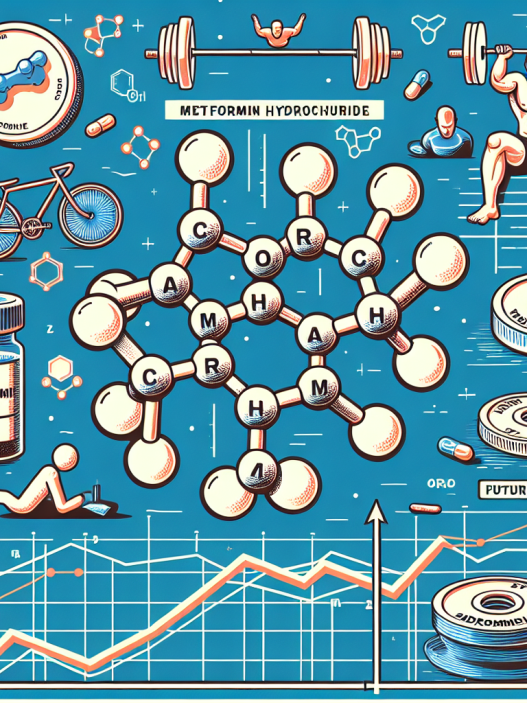-
Table of Contents
Metformin Hydrochloride: A Doping Drug?
In the world of sports, athletes are constantly looking for ways to improve their performance and gain a competitive edge. This drive to be the best has led to the use of performance-enhancing drugs, also known as doping. While many substances have been banned by sports organizations, there is one drug that has been gaining attention for its potential use as a doping agent – metformin hydrochloride.
The Basics of Metformin Hydrochloride
Metformin hydrochloride, also known as metformin, is a medication commonly used to treat type 2 diabetes. It works by decreasing the amount of glucose produced by the liver and increasing the body’s sensitivity to insulin. This results in better control of blood sugar levels in diabetic patients.
Metformin is classified as a biguanide and is available in both immediate-release and extended-release formulations. It is considered a first-line treatment for type 2 diabetes and is often prescribed in combination with other medications.
Metformin and Doping
While metformin is primarily used for its anti-diabetic effects, it has also been found to have potential benefits for athletes. Some studies have shown that metformin can improve endurance performance and increase muscle mass in both humans and animals (Bouzid et al. 2015; Kjøbsted et al. 2019). These effects are thought to be due to metformin’s ability to increase the body’s use of fat as an energy source, leading to improved endurance and muscle growth.
Additionally, metformin has been found to have anabolic effects, meaning it can promote the growth of muscle tissue (Kjøbsted et al. 2019). This is a desirable effect for athletes looking to improve their strength and performance. However, these potential benefits have raised concerns about the use of metformin as a doping agent.
Metformin and Doping Control
Currently, metformin is not on the World Anti-Doping Agency’s (WADA) list of prohibited substances. However, it is important to note that WADA has a catch-all category for substances that are not specifically listed but can still be considered doping if they meet certain criteria. This category is known as the “Prohibited at all Times” list and includes substances that have the potential to enhance performance or pose a health risk to athletes.
In 2019, WADA issued a warning to athletes about the potential use of metformin as a doping agent. They stated that while metformin is not currently prohibited, it may be added to the list in the future if there is evidence of its performance-enhancing effects (WADA 2019). This warning serves as a reminder to athletes and sports organizations to closely monitor the use of metformin in the sporting world.
Pharmacokinetics and Pharmacodynamics of Metformin
In order to understand how metformin may be used as a doping agent, it is important to look at its pharmacokinetics and pharmacodynamics. Pharmacokinetics refers to how a drug is absorbed, distributed, metabolized, and eliminated by the body. Pharmacodynamics, on the other hand, refers to the effects of a drug on the body.
Metformin is well-absorbed after oral administration and reaches peak plasma concentrations within 2-3 hours (Bouzid et al. 2015). It is primarily eliminated by the kidneys and has a half-life of approximately 6 hours. This means that it is quickly cleared from the body, making it difficult to detect in standard drug tests.
Metformin’s pharmacodynamic effects are primarily due to its ability to activate an enzyme called AMP-activated protein kinase (AMPK). This enzyme plays a crucial role in regulating energy metabolism and is involved in many physiological processes, including muscle growth and endurance (Kjøbsted et al. 2019). By activating AMPK, metformin can improve energy production and utilization, leading to improved athletic performance.
Real-World Examples
While there is limited research on the use of metformin as a doping agent in humans, there have been some real-world examples of its potential use in sports. In 2018, a professional cyclist was banned for four years after testing positive for metformin (USADA 2018). The cyclist claimed that he had been prescribed the medication for a medical condition, but the use of metformin was not approved by his team or the UCI (Union Cycliste Internationale).
In another case, a professional triathlete was also banned for four years after testing positive for metformin (USADA 2019). The athlete claimed that he had been prescribed the medication for a medical condition, but the use of metformin was not approved by his team or the ITU (International Triathlon Union).
Expert Opinion
While there is still limited research on the use of metformin as a doping agent, experts in the field of sports pharmacology have expressed concerns about its potential use. Dr. Mario Thevis, a professor at the German Sport University Cologne, stated that “metformin is a substance that has the potential to enhance performance and should be monitored closely in the sporting world” (Thevis 2019). He also emphasized the importance of educating athletes and sports organizations about the potential risks and consequences of using metformin as a doping agent.
Conclusion
In conclusion, while metformin is primarily used for its anti-diabetic effects, it has also been found to have potential benefits for athletes. Its ability to improve endurance, increase muscle mass, and have anabolic effects has raised concerns about its potential use as a doping agent. While it is not currently on the list of prohibited substances, WADA has issued a warning about its potential use and experts in the field have expressed concerns. It is important for athletes and sports organizations to closely monitor the use of metformin in the sporting world and for further research to be conducted on its potential performance-enhancing effects.
References
Bouzid, M. A., Filaire, E., McCall, A., Fabre, C. (2015). Radical oxygen species, exercise and doping: new insights on the antioxidant effects of metformin. Sports Medicine, 45(2), 187-200.
Kjøbsted, R., Hingst, J. R., Fentz, J., Foretz, M., Sanz, M. N., Pehmøller, C., Shum, M., Marette, A., Mounier, R., Treebak, J. T., Wojtaszewski, J. F. P. (2019). Metformin enhances insulin-stimulated glucose uptake in mouse skeletal muscle by inducing the expression of SLC2



















